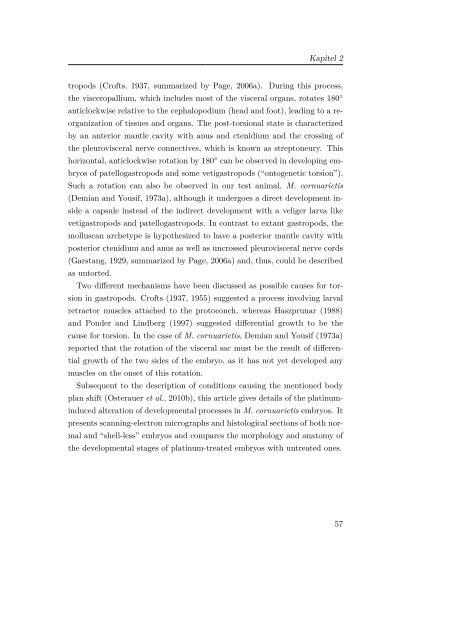Die Embryonalentwicklung der Paradiesschnecke ... - TOBIAS-lib
Die Embryonalentwicklung der Paradiesschnecke ... - TOBIAS-lib
Die Embryonalentwicklung der Paradiesschnecke ... - TOBIAS-lib
Create successful ePaper yourself
Turn your PDF publications into a flip-book with our unique Google optimized e-Paper software.
Kapitel 2<br />
tropods (Crofts, 1937, summarized by Page, 2006a). During this process,<br />
the visceropallium, which includes most of the visceral organs, rotates 180 ◦<br />
anticlockwise relative to the cephalopodium (head and foot), leading to a reorganization<br />
of tissues and organs. The post-torsional state is characterized<br />
by an anterior mantle cavity with anus and ctenidium and the crossing of<br />
the pleurovisceral nerve connectives, which is known as streptoneury. This<br />
horizontal, anticlockwise rotation by 180 ◦ can be observed in developing embryos<br />
of patellogastropods and some vetigastropods (“ontogenetic torsion”).<br />
Such a rotation can also be observed in our test animal, M. cornuarietis<br />
(Demian and Yousif, 1973a), although it un<strong>der</strong>goes a direct development inside<br />
a capsule instead of the indirect development with a veliger larva like<br />
vetigastropods and patellogastropods. In contrast to extant gastropods, the<br />
molluscan archetype is hypothesized to have a posterior mantle cavity with<br />
posterior ctenidium and anus as well as uncrossed pleurovisceral nerve cords<br />
(Garstang, 1929, summarized by Page, 2006a) and, thus, could be described<br />
as untorted.<br />
Two different mechanisms have been discussed as possible causes for torsion<br />
in gastropods. Crofts (1937, 1955) suggested a process involving larval<br />
retractor muscles attached to the protoconch, whereas Haszprunar (1988)<br />
and Pon<strong>der</strong> and Lindberg (1997) suggested differential growth to be the<br />
cause for torsion. In the case of M. cornuarietis, Demian and Yousif (1973a)<br />
reported that the rotation of the visceral sac must be the result of differential<br />
growth of the two sides of the embryo, as it has not yet developed any<br />
muscles on the onset of this rotation.<br />
Subsequent to the description of conditions causing the mentioned body<br />
plan shift (Osterauer et al., 2010b), this article gives details of the platinuminduced<br />
alteration of developmental processes in M. cornuarietis embryos. It<br />
presents scanning-electron micrographs and histological sections of both normal<br />
and “shell-less” embryos and compares the morphology and anatomy of<br />
the developmental stages of platinum-treated embryos with untreated ones.<br />
57
















